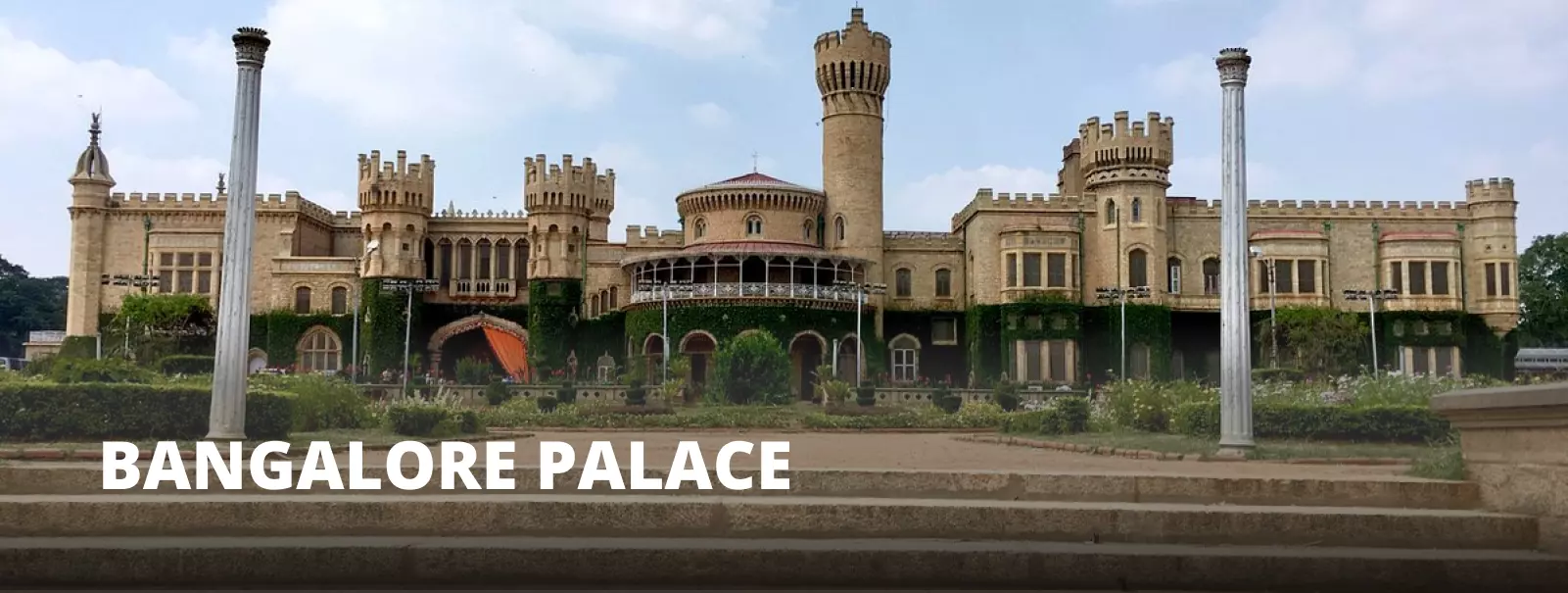
Location: Bangalore
Built by: Wadiyar dynasty
Built in the Year: 1878
Architectural style: Todur and Scottish-Gothic style architecture
Timings: 10am – 5pm
Entry Fee: Rs250 for Indians, Rs460 for Foreigners
A fine specimen of an exquisite architecture and grandeur, the magnum opus known as Bangalore Palace contains in it the spice of old regal charm and opulence. Located at the tech-city Bangalore, the Bangalore Palace is the central attraction of the city and is a peaceful contrast of regal architecture and imperial design with that of the usual skyscrapers and the cityscape of concrete forest.
Built in the year 1878, the palace was originally bought in 1873 by Chamarajendra Wadiyar’s British guardians from the principal of Bangalore Central High School, Reverend J Garret, from his funds. This extraordinarily expansive edifice is spread in an area of 45,000 square feet and showcases an exquisite blend of Tudor and Scottish Gothic architecture which is enhanced by the intricate carvings on the walls that oozes royalty in different ways. Apart from being a majestic tourist attraction, the palace acts as a host for major cultural events, rock shows, and marriage functions which are taken place at the vast open ground in the premises. The granite seats ornamented with florescent blue ceramic tiles on the ground floor, the legendary painter Raja Ravi Verma’s paintings, a huge ballroom right from the fairy tale romance, vine-covered walls, and the Durbar Hall on the first floor are some of the many exquisite things that make up the magnificent and the alluring Bangalore Palace.
The area of the Bangalore Palace formerly belonged to the school principal of the cantonment town, Reverend J Garret who sold the property to the British guardians of the minor Maharaja Chamarajendra Wadiyar in 1973, who bought the palace so that his education and administrative training could take place easily. The construction started in the year 1974 and under the administration the artistic mind John Cameron, the palace got completed in 1878 AD. The palace saw many additional constructions and improvements in the following years and renovations took place frequently so that the palace could hold the resemblance of the Windsor Castle of London that had bestowed and inspired the king to build this palace.
The palace opened its gate to the public in 2005 and has experienced many legal activities in lieu of its ownership. Currently, the ownership lies with the descendant of the Mysore Royal Family, Srikanta Datta Narasimharaja Wadiyar.

An epitome of architectural brilliance and regal magnificence, the Bangalore Palace lets you into the journey of grandeur and lifestyle of the Wadiyars, the erstwhile royal family of the Kingdom of Mysore. Built in the Tudor Revival style of architecture, complete with turrets, battlements, a ballroom, royal bed chambers, and fortified towers, Bangalore Palace is a two-storied edifice with Roman arches marking the entrance and the floor sprawled across 45,000 sq. feet. The interior of the palace is adorned with elegant wood carvings, cornices, floral motifs, and relief paintings on the ceiling along with the exquisite furniture featuring neo-classical, Edwardian, and Victorian elements that enhance its regal charm. The huge stained glass and mirrors that have been bought from England along with the wooden fans lend the palace an old-warm allure. Around 35 rooms in the palace make up most of the design out of which most are bedrooms and a swimming pool. The open courtyard inside the fortress is a place of visual attraction because of the stunning fluorescent blue ceramic tiles used in its décor. Pillars and arches dominate the interiors of the Bangalore Palace along with ornate cornices, chandeliers, and patterned walls add to the lavishness of its regal setting. One of the chief attractions of the palace is the Durbar Hall that has a gigantic elephant head adorning it. Located on the first floor, the hall has stained glass floor to ceiling windows and a screen demarcating the area behind which the women would sit and watch the assembly proceedings in the bygone era.
Apart from the astounding interior and architecture, the palace houses several other artifacts and decorative material that demand attention. The courtyard of Maharaja showcases a beautiful fountain that was presented by an erstwhile Spanish royal and a painted tile bench that bragsof the art-deco design. Paintings of the renowned artist Raja Ravi Verma and other artists from the 19th and 20th century, a large collection of photographs that chronicles the several generations of the Wadiyar dynasty along with offering a glimpse into the evolution of Bangalore over the last century.
The Bangalore Palace is located at the center of the city and can be reached by BMTC local buses 287, 287B, 287C, 287D, and 287E from the central bus terminal. The palace can also be reached through private cabs or auto rickshaw easily and the timings are from 10am to 5:30pm.

Witness the magnificent and majestic opulence of the Bangalore Palace and its Tudor-Scottish Gothic architecture that was built in the year 1878. Home to the heir of the Mysore Royal Family, Srikanta Datta Narasimharaja Wadiyar, the Bangalore Palace is the epitome of elegance and luxury and also acts as a host to several events and ceremonies.
Copyright 2012-2022 Indiamap Digital Pvt Ltd. All rights reserved. Privacy Policy | Terms of Use